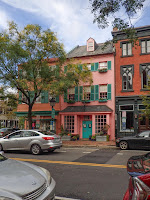It's a Saturday and none of us feel like going into DC proper, so we opt for Alexandria, VA, which is located just south of DC on the banks of the Potomac River.
 |
| Map showing Alexandria VA and surrounding area |
|
Alexandria started off as a British colonial town and predates both the American Revolution and Washington DC. In October of 1669, 6,000 acres were granted to Robert Howsing to help transport 120 people to the colony of Virginia. Not long afterwards, this tract of land became the City of Alexandria. Today the Old Town is known for its brick sidewalks and wonderfully preserved 18th and 19th century buildings. No wonder, it is a favorite place to live for many Washington DC professionals.
 |
| Founders' plaque has become eroded |
|
 |
| More readable version |
|
Alexandria, Virginia
County Seat of Fairfax 1742 - 1800
Organized 13th July, 1742
Incorporated by the Assembly of Virginia 1779
Ceded to the Federal Government 1789
First Boundary stone of the Federal District laid 15th of April 1791
Capitulated to the British 28th of August 1814
Retroceded to Virginia July 1846
|
After finding parking, we wander the streets of the Old Town. The old brick sidewalks and old buildings are a real treat to see.
 |
| Brick sidewalks |
|
 |
| Old brick building used as a store and apartments |
|
 |
| Historic details |
|
The older buildings and homes are a real treat for us - much different than California.
As we walk around Old Town, we notice a plaque on the sidewalk. It's a trap door that was used to drop blocks of ice from the Potomac River into bails of hay for use throughout the warmer months by the tavern next door.
We turn the corner and notice the
Gadsy's Tavern sign. This old tavern was built around 1785 and became a central part of the social, economic, political life of Alexandria. Yes - of course, George Washington really did eat here.
 |
| Gadsy's Tavern sign |
|
 |
| George looks hungry |
|
 |
| House season specialty - Pumpkin Ale |
|
The inside is worth seeing as it retains many original features. Even though we enjoy the food, we especially like getting a feel of what it was like to dine and drink here post Revolution United States.
 |
| Bar area |
|
 |
| Peter likes his Pumpkin Ale |
|
 |
| Chicken pot pie |
|
Back on the street, we notice a building with flood water level markings literally set in stone. Looks like the Potomac River flooding Old Town Alexandria isn't all that uncommon.
We also find
Nicecream, a liquid nitrogen ice cream shop. Of course, we stop for dessert. The staff put on quite a show assembling our orders with the nitrogen bubbling over the mixing bowls. Feels like
Dr. Frankenstein's Lab. Although the ice cream is really good and the nitrogen puts on a great show, I can't decide if it actually tastes better than any other high quality ice cream.
As we wander outside, we notice a store featuring risque lingerie. Power politics and sex do always seem to go together.
Next we walk over to the
Torpedo Factory, which has been renovated as an art center. Yes - this building once housed an actual torpedo factory. The US Navy began construction shortly after Armistice Day, November 12, 1918, which marked the end of WWI. After the building was completed in 1923, it served as a munitions storage until 1937 when production started on the
Mark XIV, the Navy's standard submarine-launched anti-ship torpedo of WWII. After the war ended, the factory briefly manufactured parts for rocket engines before closing down in 1946. On May 7, 1974 the Art League was granted their request to renovate and use the building. Today the center provides working and selling space to more than 165 artists.
 |
| River front patio behind Torpedo Factory |
|
 |
| Historical Timeline |
|
 |
| 3000 pound Mark XIV torpedo |
|
Inside we find a large open and airy space lined with many different shops and work areas.
Some larger art pieces are displayed in the main walkways. Our favorite is the
papier mache Tyrannosaurus Rex plastered with dollar bills.
We really enjoyed our day in Alexandria and plan to take a
historical walking tour on our next visit.































































